Geography of Ghana
The geography of Ghana is varied and complex, characterized by low hills, plains, rivers, and coastal areas. Located in West Africa along the Gulf of Guinea in the North Atlantic Ocean, it borders Togo to the east and Ivory Coast to the west. The terrain consists mainly of grassy plateaus with scattered mountains up to 2,905 feet high at Mount Afadjato.
The three main regions are the Northern Region containing savanna vegetation, the Ashanti Region comprising tropical rainforest; and the Volta Region, which combines forested hills and open valleys with dry grasslands. Numerous small rivers flow through these regions, such as the White Volta River, Oti River, and Ankobra River supplying fresh water for various activities, including farming and industrial purposes. Ghana’s coastline stretches 348 miles, providing many fishing opportunities but it has become increasingly more developed due to tourism industry growth over recent years.
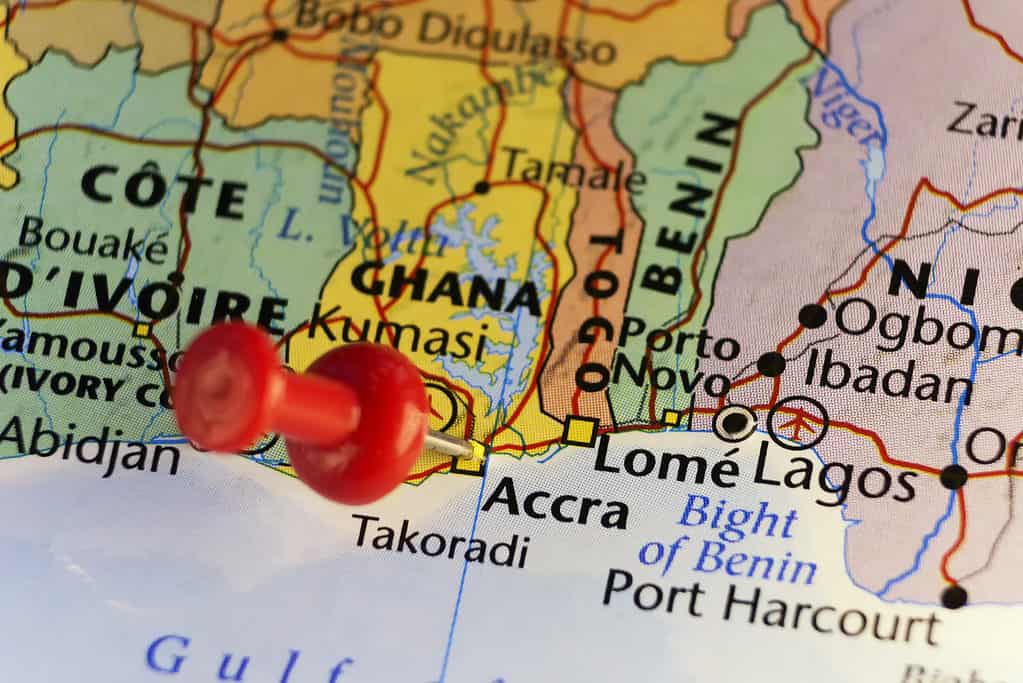
Located in West
Africa
along the Gulf of Guinea in the North Atlantic Ocean, it borders Togo to the east and Ivory Coast to the west.
©Llucky78/Shutterstock.com
People and Culture
Ghana is a culturally diverse country located in West Africa. It has a population of around 29 million people and over 100 different ethnic groups. The official language is English, but there are also many other local languages spoken by various ethnic groups.
Ghanaian culture is rich in music and art, with traditional dances such as Adowa being popular throughout the country. This vibrant cultural heritage is reflected in festivals such as Homowo (celebrated by the Ga-Adangbe people) and Damba (celebrated by the Dagomba).
In addition to these cultural celebrations, Ghana has an impressive array of national monuments and historical sites reflecting its long settlement, trade, and exploration history. From castles on the coast to ancient burial grounds deep within the forested interior, there’s something for everyone interested in exploring Ghana’s past.
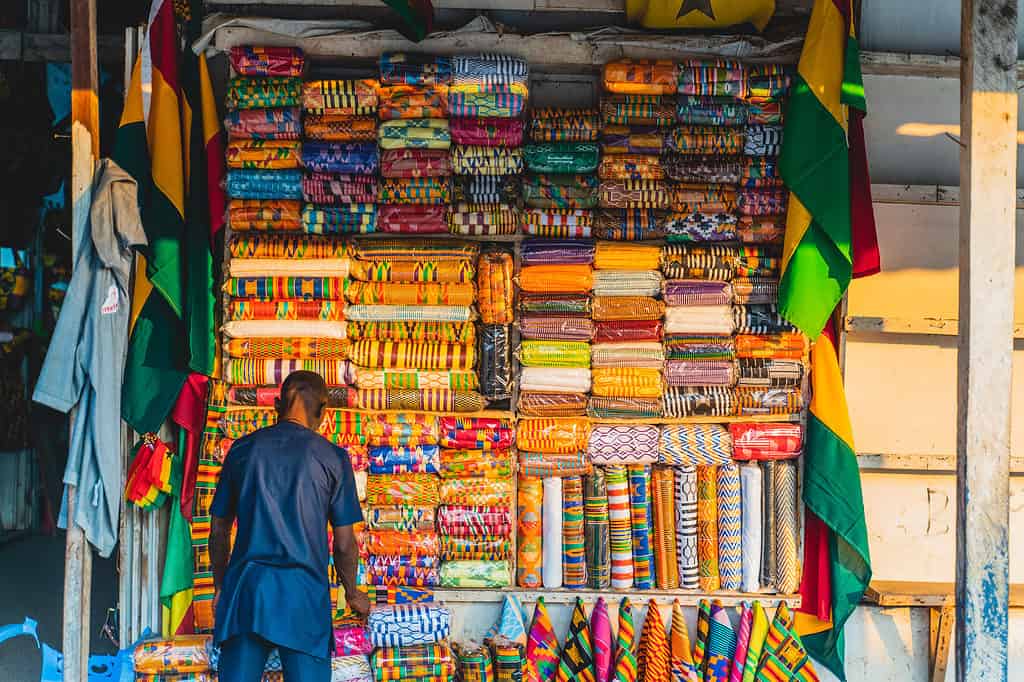
Ghana is a culturally diverse country located in West
Africa
. It has a population of around 29 million people and over 100 different ethnic groups.
©Steven Harewood/Shutterstock.com
Plants in Ghana
Ghana is home to several impressive plant species, both native and non-native. Some examples of native plants that grow wild in Ghana include the African tulip tree, African sandalwood, flame lily, and fan palm. Numerous types of grasses are also found throughout the country, including elephant grass and Guinea grass.
Trees such as mahogany, teak, and African ebony can be found in the forests across Ghana. Shrubs like baobab trees, roses, and hibiscus are commonly found in many parts of the country. Vines, including wild grapes and passion fruits, are abundant along roadsides or climbing up tree trunks. Flowers such as bougainvillea and frangipani bloom in gardens or parks during warmer months. Ferns like bracken fern grow naturally near streams or rivers, while mosses cover rocks with verdant green carpets on mountaintops. Lichens adorn rocks on hillsides with colorful patches of reds, greens, blues, yellows, and purples. These plants all contribute to making Ghana a beautiful place to live!
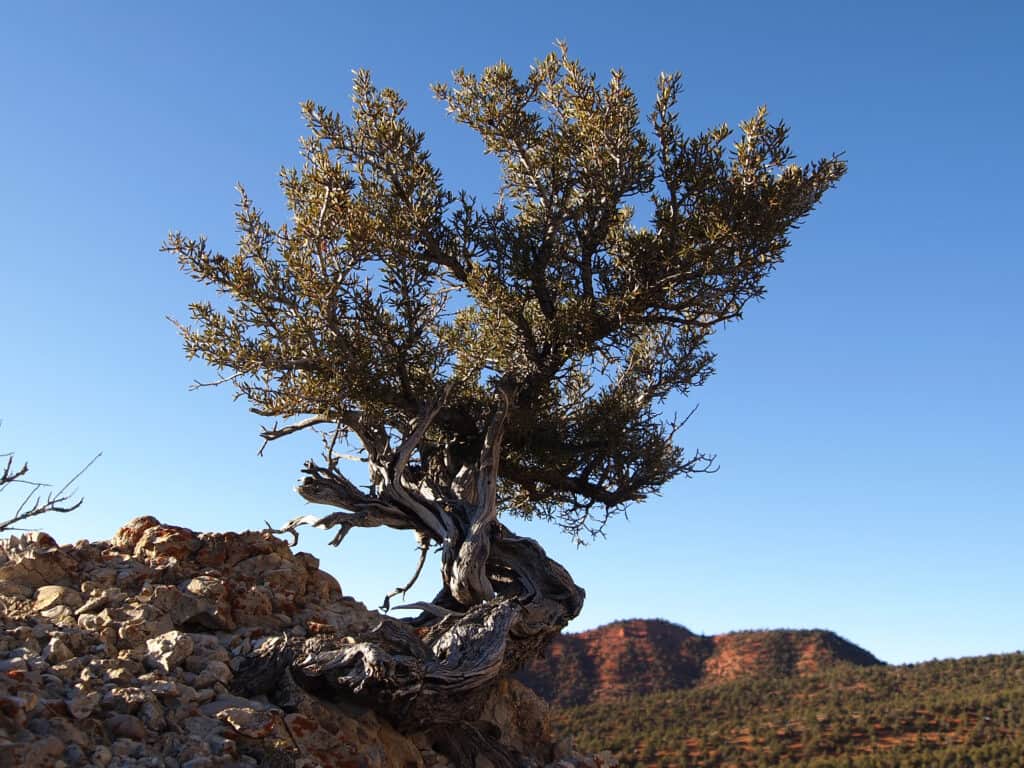
Trees such as mahogany can be found in the forests across Ghana.
©iStock.com/Ellend1022
National Flower
The Impala Lily, also known as the Desert Rose (Adenium obesum), is the official national flower of Ghana. This species of flowering plant is a part of the Western Afro-Floral emblem and blooms during the dry season in its native habitat. It is characterized by its vibrant pink petals and dark red center, adding to its beauty that has made it popular amongst both locals and tourists alike. The Impala Lily is an important symbol of Ghanaian culture and pride, representing strength and resilience even in difficult conditions.
What is an Impala Lily?
The Impala Lily, scientifically known as Adenium obesum, is a flowering plant of the dogbane family (Apocynaceae). It has an incredibly wide range and can be found in regions such as the Sahel south of the Sahara, tropical and subtropical eastern and southern Africa, and even parts of Arabia. It has many different names, including Sabi star, kudu, mock azalea, desert rose, and its most common name – Impala lily.
This impressive plant can grow up to 16 feet tall with thick stems with a swollen rootstock at its base. Its leaves are leathery in texture with spiraling patterns, which make them easily recognizable. The flowers on this particular species come in vibrant shades of red or pink, with five petals arranged around a white center. Ghana chose this captivating flower to represent its national identity. Hence it is referred to as the National Flower of Ghana!

This species of flowering plant is a part of the Western Afro-Floral emblem and blooms during the dry season in its native habitat.
©Chaikovsky/Shutterstock.com
How to Grow
Adenium obesum, commonly known as the Impala Lily, is a popular bonsai and houseplant in temperate climates. It thrives well in sunny locations and needs a minimum indoor temperature of 50°F in winter. This resilient flower can be propagated by seed or stem cuttings, and its numerous hybrids can be propagated by grafting onto seedling rootstock.
Desert Rose is native to arid or semi-arid climates, but it can flourish in tropical and semi-tropical settings with plenty of sun, warmth, and well-draining soil. In very hot climates, it can be kept outdoors all year round with temperatures of at least 70°F up to 100°F. For those living in North America and other places where the temperature drops below 40°F, this plant will need to be brought inside during the winter or grown in a greenhouse.
The Impala Lily is a rugged, long-lived plant that can provide years of enjoyment. It can be planted in a garden, kept as a container plant, or even grafted together as a bonsai. With proper tending, this flower may become a cherished companion over the years.
Other Uses
Impala lily, the national flower of Ghana, has a variety of other uses as well. Most notably, it is used as an arrow poison and fish toxin. This practice makes hunting easier for those who use bows and arrows to hunt wild animals or catch fish in rivers or lakes. It can be used directly on the tip of the arrow or added to bait.
The Impala lily is also believed to have medicinal properties. It is popularly used in traditional African medicine due to its antiseptic properties. Moreover, this beautiful flower has aesthetic value too. It produces long-lasting blooms which attract hummingbirds and pollinators like bees and butterflies making it perfect for any garden or backyard landscape design.
What Animals Eat Impala Lily?
The polka-dot wasp moth (Syntomeida epilais) is a species of insect that feeds on the Impala Lily, also known as the desert rose. While in the caterpillar stage, they feast upon both the impala lily and oleanders to survive.
Nectar from the flowers sustains pollinators like bees, butterflies, and hummingbirds. In areas with warm weather throughout the year, these flowers can bloom all twelve months of the year.
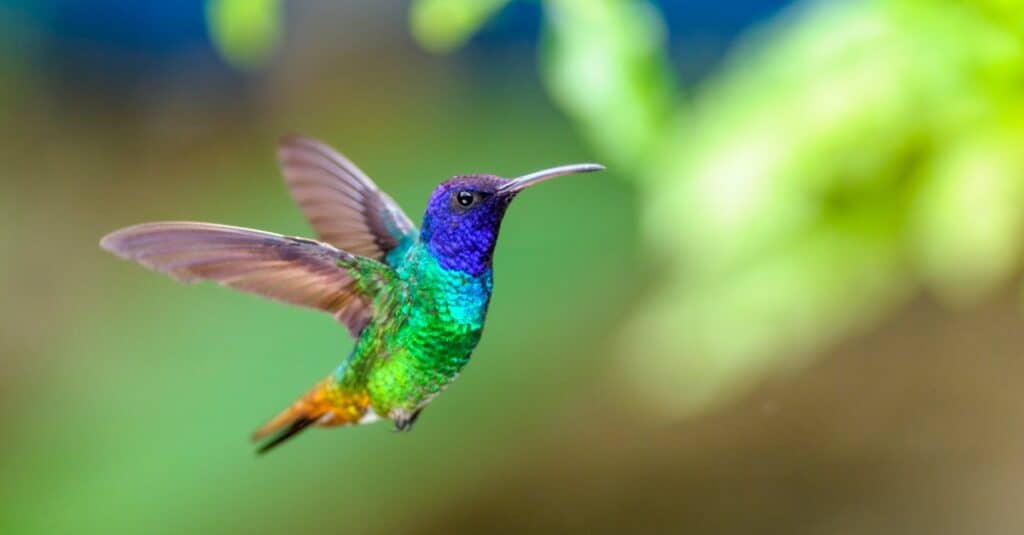
Nectar from the flowers sustains pollinators like Hummingbirds.
©iStock.com/photofxs68
Wildlife of Ghana
Ghana is home to a wide variety of wildlife, ranging from large mammals like African elephants and lions to smaller animals such as antelopes and baboons. There are also many species of primates in Ghana, including chimpanzees, colobus monkeys, and patas monkeys.
Other larger animals found in the country include leopards, cheetahs, buffalo, wild boars, hippos, and warthogs. As for reptiles, there are various types of snakes living in Ghana, including cobras, puff adders, tortoises, and monitor lizards. In addition to these land-based creatures, there are a number of bird species native to the area, such as kingfishers, bee-eaters, and hornbills. Aquatic life includes Nile crocodiles inhabiting rivers throughout the region.
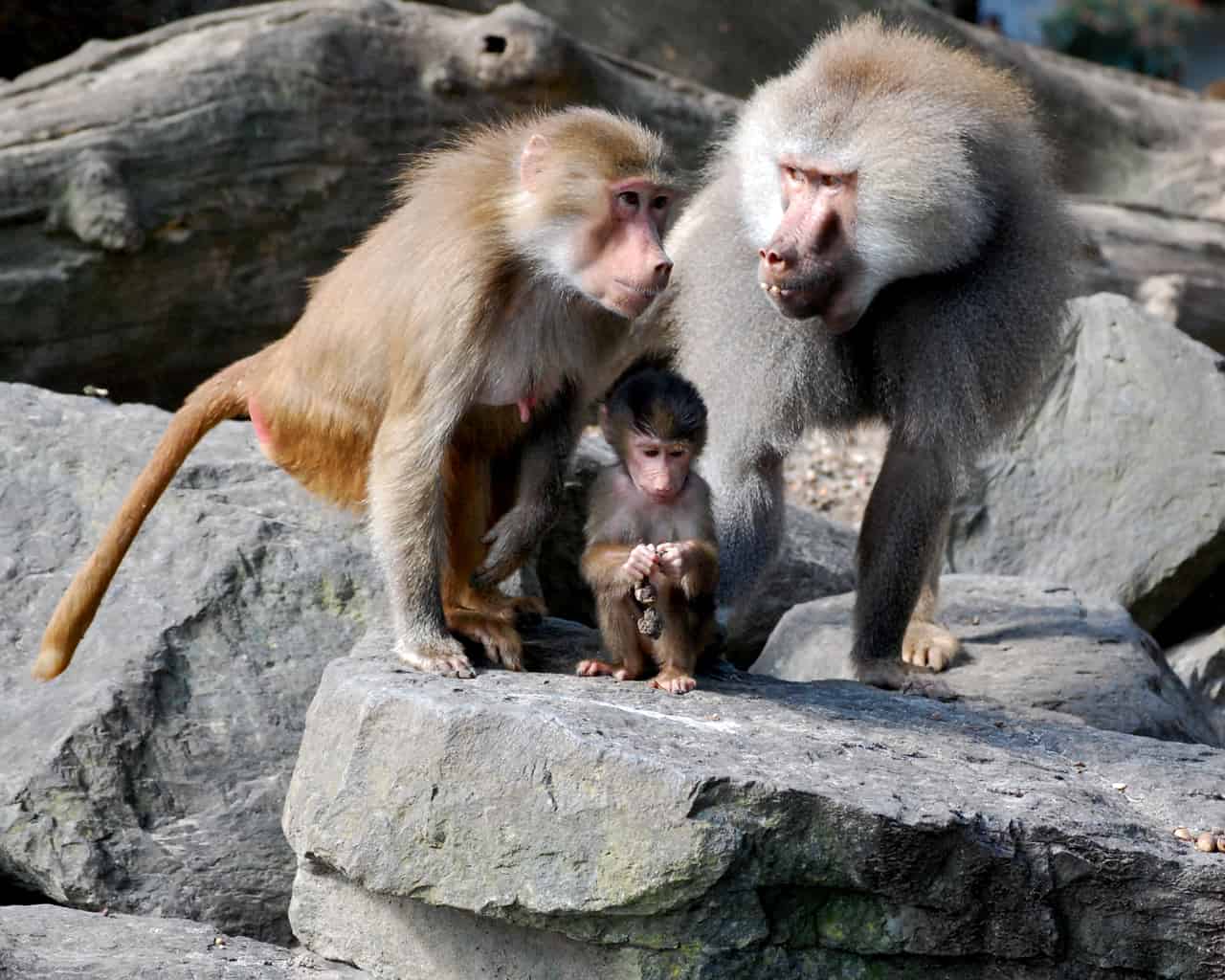
Ghana is home to a variety of wildlife, including baboons.
©Dick Mudde, Public domain, via Wikimedia Commons – License
What Other flowers Grow in Ghana?
In addition to the Impala Lily, Ghana is also home to many other beautiful flowering plants. Some of these include hibiscus, orchids, frangipani, bougainvillea, African daisies, and aloe vera. These plants can be found in gardens throughout the country. They are often used as ornamentals due to their vibrant colors and attractive shapes.

In addition to the Impala Lily, Ghana is also home to many other beautiful flowering plants.
©iStock.com/cgdeaw
Next Up
The photo featured at the top of this post is © Noypb/Shutterstock.com
FAQs (Frequently Asked Questions)
Why is the Impala Lily Ghana’s national flower?
The Impala Lily is an important symbol of Ghanaian culture and pride, representing strength and resilience even in difficult conditions.
How do you care for an impala lily?
Adenium obesum, commonly known as the Impala Lily, is a popular bonsai and houseplant in temperate climates. It thrives well in sunny locations and needs a minimum indoor temperature of 50°F in winter. This resilient flower can be propagated by seed or stem cuttings, and its numerous hybrids can be propagated by grafting onto seedling rootstock.
Thank you for reading! Have some feedback for us? Contact the AZ Animals editorial team.






